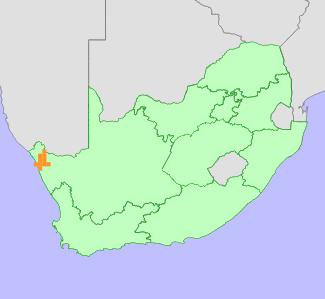|
Scientific Name | Conophytum hians N.E.Br. |
Higher Classification | Dicotyledons |
Family | AIZOACEAE |
Synonyms | Conophytum elongatum Schick & Tischer, Conophytum gothicum Tischer, Conophytum hians N.E.Br. var. acuminatum L.Bolus, Conophytum hirtum Schwantes, Conophytum miserum N.E.Br., Conophytum parvimarinum L.Bolus |
National Status |
Status and Criteria | Near Threatened A4cd |
Assessment Date | 2021/11/25 |
Assessor(s) | A.J. Young, P.G. Desmet, I. Ebrahim, D. Guo, A. Harrower, L. Jabar, L. Knoetze, C. Rodgerson & P.C.V. Van Wyk |
Justification | This succulent is endemic to the Northern Cape province of South Africa with an extent of occurrence (EOO) of 3,592 km² and area of occupancy (AOO) of 172 km². The population is experiencing initial levels of decline due to the illegal ornamental succulent plant trade, with collection likely to increase as there has been a dramatic increase in the number of species and volume of plants targeted since 2019. The dispersed distribution across many locations is, however, likely to restrict the overall impact of illegal collection on this species. A decline of up to 28% is likely within the next three generations (90 years) primarily due to the loss of mature individuals to illegal collection. Climate change is also impacting the population although there is uncertainty of the response given the expected resilience of this species. This species is approaching the decline thresholds for listing as Vulnerable and is therefore listed as Near Threatened under criterion A4. |
Distribution |
Endemism | South African endemic |
Provincial distribution | Northern Cape |
Range | This succulent is restricted to the Richtersveld region of the Northern Cape province of South Africa where it is found in numerous localities. |
Habitat and Ecology |
Major system | Terrestrial |
Major habitats | Desert, Succulent Karoo |
Description | This species is widespread across the Succulent Karoo and Desert biomes; primarily within the Richtersveld bioregion but also the Gariep Desert and Namaqualand Sandveld bioregions. The plants typically occupy small, often flat, patches of quartz stones. This species has a generation length of 30 years. It is expected to be sensitive to the impacts of climate change as it does not disperse and while adapted to arid conditions, is dependent on limited seasonal rainfall. Species in the genus are sensitive to long periods of drought. Drought related mortality has been observed for other closely related taxa within the genus. |
Threats |
| This species is currently threatened by illegal collection for the international trade in ornamental succulents. This is likely to increase in future as there has been a dramatic increase in the number of species and volume of plants targeted since 2019.
Anthropogenic climate change is a long-term threat to this species. Climate models for the likely emission scenarios where emissions stay at present day levels (RCP 2.6) (Hausfather and Peters 2020) and worst case scenarios where emissions continue to increase during the 21st century (RCP 8.5) indicate that there will be a loss of suitable bioclimatic envelope of between 7% and 14% by 2080 for this species. However, as this taxon possesses certain morphological traits likely to afford resilience to xerophytic conditions and is found across several vegetation units it is expected to have a level of resilience to climate change and the expected population loss is reduced by 20% to negligible levels. Species in this genus have limited dispersal ability and migration to suitable habitats elsewhere is regarded as highly unlikely. |
Population |
This small succulent is relatively widespread and is found in numerous small, sometimes isolated, subpopulations ranging in size from hundreds to thousands of plants. It is plentiful in habitat with considerably more than 100,000 plants likely to be present. The population is experiencing initial levels of decline due to illegal collection. The population is additionally suspected to be declining in response to an extended drought in the Richtersveld that started in 2016 and is still ongoing at the time of assessment.
|
Population trend | Decreasing |
Assessment History |
Taxon assessed |
Status and Criteria |
Citation/Red List version | | Conophytum hians N.E.Br. | Least Concern | Raimondo et al. (2009) | |
Bibliography |
Hammer, S. 2002. Dumpling and his wife: New view of the genus Conophytum. EAE Creative Colour, Norwich.
Hammer, S.A. 1993. The genus Conophytum: A conograph. Succulent Plant Publications, Pretoria.
Hausfather, Z. and Peters, G.P. 2020. Emissions - the 'business as usual' story is misleading. Nature 577(618-620).
IUCN. 1994. IUCN Red List Categories version 2.3. Prepared by the IUCN Species Survival Commission, IUCN, Gland, Switzerland.
Opel, M.R. 2004. The rediscovery of Crassula alcicornis. Haseltonia 10:38-40.
|
Citation |
| Young, A.J., Desmet, P.G., Ebrahim, I., Guo, D., Harrower, A., Jabar, L., Knoetze, L., Rodgerson, C. & Van Wyk, P.C.V. 2021. Conophytum hians N.E.Br. National Assessment: Red List of South African Plants version 2024.1. Accessed on 2025/11/07 |
 Comment on this assessment
Comment on this assessment


